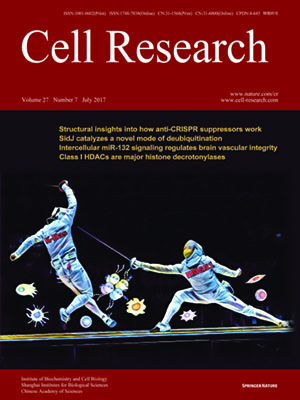
Volume 27, No 7, Jul 2017
ISSN: 1001-0602
EISSN: 1748-7838 2018
impact factor 17.848*
(Clarivate Analytics, 2019)
Volume 27 Issue 7, July 2017: 898-815
ORIGINAL ARTICLES
Class I histone deacetylases are major histone decrotonylases: evidence for critical and broad function of histone crotonylation in transcription
Wei Wei1,2,*, Xiaoguang Liu1,*, Jiwei Chen1,*, Shennan Gao1, Lu Lu1, Huifang Zhang1, Guangjin Ding1, Zhiqiang Wang1, Zhongzhou Chen3, Tieliu Shi1, Jiwen Li1, Jianjun Yu4,5 and Jiemin Wong1,2
1Shanghai Key Laboratory of Regulatory Biology, The Institute of Biomedical Sciences and School of Life Sciences, East China Normal University, Shanghai 200241, China
2Joint Research Center for Translational Medicine, East China Normal University and Shanghai Fengxian District Central Hospital, No. 6600, Nanfeng Road, New Nanqiao Town, Fengxian District, Shanghai 201499, China
3Beijing Advanced Innovation Center for Food Nutrition and Human Health, China Agricultural University, Beijing 100193, China
4Department of Urology, Shanghai Jiao Tong University Affiliated Sixth People's Hospital, No. 600, Yishan Road, Xuhui District, Shanghai 200233, China
5Department of Urology, Shanghai Sixth People's Hospital South Campus, No. 6600, Nanfeng Road, New Nanqiao Town, Fengxian District, Shanghai 201499, China
Correspondence: Jianjun Yu, E-mail: yujj917@163.com; Jiemin Wong,(jmweng@bio.ecnu.edu.cn)
Recent studies on enzymes and reader proteins for histone crotonylation support a function of histone crotonylation in transcription. However, the enzyme(s) responsible for histone decrotonylation (HDCR) remains poorly defined. Moreover, it remains to be determined if histone crotonylation is physiologically significant and functionally distinct from or redundant to histone acetylation. Here we present evidence that class I histone deacetylases (HDACs) rather than sirtuin family deacetylases (SIRTs) are the major histone decrotonylases, and that histone crotonylation is as dynamic as histone acetylation in mammalian cells. Notably, we have generated novel HDAC1 and HDAC3 mutants with impaired HDAC but intact HDCR activity. Using these mutants we demonstrate that selective HDCR in mammalian cells correlates with a broad transcriptional repression and diminished promoter association of crotonylation but not acetylation reader proteins. Furthermore, we show that histone crotonylation is enriched in and required for self-renewal of mouse embryonic stem cells.
10.1038/cr.2017.68
FULL TEXT | PDF
Browse 1762


